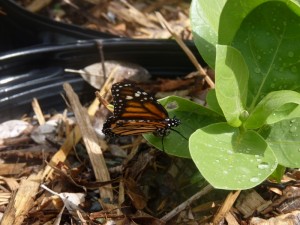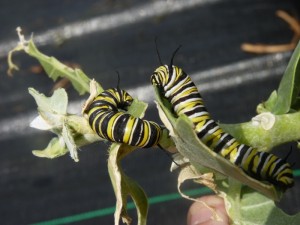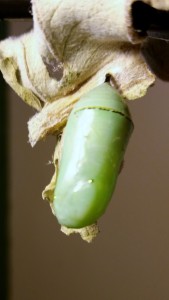
Monarch Butterflies in the US Virgin Islands
We became recently aware of some interesting, members of the St. Croix community. While working in the tree nursery, we first noticed some severe damage to some plants in the milkweed family. Caterpillars. A quick investigation made us put away the pesticide and take our our cameras. Monarch Butterflies and caterpillars! Are they residents or are they migrating?
We spotted this female Monarch butterfly (Danaus plexippus) busy at work. Monarchs are a threatened, protected species. Many people say the Monarch is the king of the butterflies. The beauty of the caterpillar and the butterfly earns it this regal common name. She and a few others were moving from plant to plant, laying a single egg each time. They were not easy for this novice to capture on camera. The adult butterfly may only live for 2 to 6 weeks and a female will lay roughly 100 to 300 eggs in her life.
Further investigation revealed both hungry caterpillars and freshly laid eggs on our plants. The Monarch butterfly has a very interesting life cycle and migration is one of the keys to their success. Their migration man be the most evolved pattern in any insect and their trip exposes them to several risks along the way. Like many butterflies, they go through four life stages, egg, larvae (caterpillar), pupae (chrysalis), and adult butterfly. The whole process can be completed in as little as a month. The species is on the move almost all the time. Most descriptions of their migration focus on route that begins in Mexico and goes to Texas, south Canada and back again. Clearly there is a percentage of the population that takes the long way around and goes through the Caribbean.
This link from a group in Texas tells you where are they now?
Many of the caterpillars on our plants have formed cocoons already. We expect new Monarch Butterflies to emerge soon and perhaps begin their northward migration. However, the US Virgin Islands is quite a bit out of the way from the normal North-South migration pattern. Are these resident monarchs? We have not seen that phenomenon described before. We will keep you posted right here.





Comments
Do they go anywhere else besides Mexico? Someplace in Venezuela, for instance? Is this known?
I included a bunch of hotlinks in the blog post that will take you to other monarch projects. Most of them are small scale project with a regional focus. Im certainly no expert, but after reading a bunch of them, my understanding is that the vast majority of monarchs overwinter in the low mountains of mexico. I have not read anything about smaller populations overwintering in venezuala or any other place. I also did not find much of anything written on the migratory path that takes them through the Virgin Islands
Comments, Questions? Contact Us.